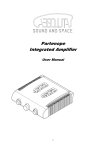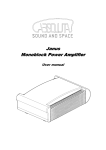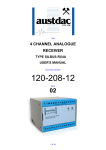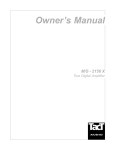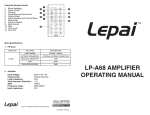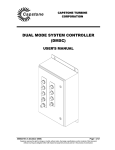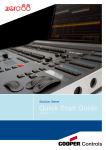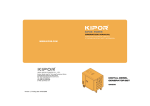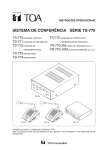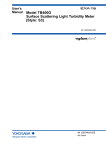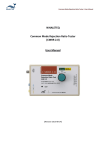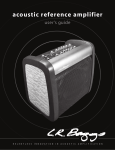Download Talia manuale uso inglese rivisto ALE
Transcript
Talia Stereophonic Preamplifier User manual Important Safety Instructions 1. Read these instructions. 2. Save these instructions. 3. Pay attention to all advices. 4. Always follow instructions. 5. Do not use this unit in presence of water. 6. Clean with a dry cloth only. 7. Do not obstruct venting holes and heat sinks. Install as indicated by the manufacturer. 8. Do not install near heat sources such as heaters, heat pumps, stoves or other equipment which produce heat. 9. Do not alter the functionality of a polarized plug or one provided with earth connection. A plug is polarized when it can be fitted in the mains socket in one way only. A plug provided with earth connection has two prongs for current and a third one for earth connection. The latter is provided for user’s safety. If the plug provided doesn’t fit your mains socket, consult your technician to obtain the replacement of the obsolete mains socket. 10. The mains cable represents the emergency detachment device for this unit. It’s important to grant a quick access to this cable in every moment. 11. Protect the mains cable against trampling and mashing, particularly close to the plug and to the connector at the input socket of the unit. 12. Use only connectors and accessories specified by the manufacturer. 13. Only use the cart, stand, tripode or table specified by the manufacturer or sold with the unit. When using a cart, pay attention while shifting the cart/unit ensemble to avoid harming people or flipping the cart upside down. 14. Isolate the unit from mains during lightning storms or when it’s not operated for long. 15. Refer all servicing to qualified personnel. Servicing is required when the unit is damaged due to any reason, e.g. when mains cable or plug are damaged, when a liquid is spilled on it or when objects drop on the unit, when the unit is exposed to rain or moisture, or when the unit is not operative or has been dropped from whatever height. The replacement of the outer shell must be considered a service operation. 16. Venting must not be impeded by obstructing venting holes and heat sinks with objects like newspapers, towels, curtains and the like. 17. Do not place any free flame, like a candle or the like, on the unit. 18. Terminals marked with this label must be considered DANGEROUS and the connections external to these terminals require servicing by a TRAINED TECHNICIAN or the use of factory prepared cables. Warning! To reduce the risk of fire or electric shock, do not expose this unit to rain or to moisture. Do not place objects containing liquids, like bowls or glasses, on this unit. 2 Warning! Changes or modifications not authorized by the manufacturer can invalidate the compliance to CE regulations and can cause the unit not to be suitable for use any longer. The manufacturer rejects any responsibility regarding damages to people or to things caused by the use of a unit which has been subject to unauthorized modifications or caused by the misuse or by the malfunction of a unit which has been subject to unauthorized modifications. 3 Instructions for Recycling The label on the left, printed on the envelope of the product, indicates that the product, when no more usable, can’t be treated as generic garbage. The product must be disposed of at a collection point for recycling of electrical and electronic equipment, in compliance with WEEE regulations (Waste of Electrical and Electronic Equipment). By making sure that this unit is correctly recycled, you will help preventing potential damages to the environment and to human health. Recycling helps saving natural resources. For more in-depth information about recycling this product, please contact Absoluta Sound and Space Srl. ABSOLUTA SOUND AND SPACE Galleria Andrea Urbani, 3 35027 Noventa Padovana (PD) Ph. : Fax. Web: +39.049.8935377 +39.049.8935377 www.absoluta.it Customer Service Phone: +39.049.8935377 Fax: +39.049.8935377 e-mail: [email protected] P/N: 1234557 – Rev. 1.0 – 03/09 “Absoluta Sound and Space” and the logo Absoluta are registered trademarks of Absoluta Sound and Space Srl. © Absoluta Sound and Space Srl. All right reserved. This manual should not be construed as a commitment on the part of Absoluta Sound and Space Srl. The information it contains is subject to changes without notice. Absoluta Sound and Space assumes no responsibility for errors that may appear within this document. 4 Safety Terms and Symbols This document contains instructions on generic safety, installation and use for the Talia stereophonic preamplifier. It’s important to read this document before trying to use this amplifier. Pay particular attention to safety instructions. Appears on the unit to indicate the presence of uninsulated, dangerous voltages inside the enclosure - voltages sufficient to constitute a risk of shock. Appears on the unit to indicate important operation or maintenance instructions included in the accompanying documentation. Appears on the unit to indicate compliance with the EMC (Electromagnetic Compatibility and LVD (Low-voltage Directive) standards of the European Union. Warning! Calls for attention to a procedure, practice condition, or the like that, if not correctly performed or adhered to, could result in personal injuries, death or damages to the unit or to other objects. Note Calls for attention to information that is essential to highlight 5 This page has been intentionally left blank 6 Table of Contents Introduction ..................................................................... 9 Special Design Features ................................................... 9 Unpacking ....................................................................... 12 Installation Considerations .............................................. 13 Power Requirements ...................................................... 15 Operation ....................................................................... 17 Front Panel ..................................................................... 17 Back Panel ...................................................................... 20 Remote Control ............................................................... 26 Connections .................................................................... 29 General Connections Scheme ........................................ 31 Balanced Connection to Power Amplifier ........................ 33 Troubleshooting............................................................ 35 Maintenance .................................................................. 35 Troubleshooting .............................................................. 35 Maintenance ................................................................... 38 Specifications................................................................ 39 Dimensions.................................................................... 41 7 This page has been intentionally left blank 8 Introduction Special Design Features Design Principles Dear Customer, thank you for purchasing Talia stereophonic preamplifier. Talia combines the performance, versatility, purity and definition of a great multi-chassis preamplifier with the small form factor of an integrated preamplifier. It delivers the great sound, that only the best products can deliver, and has an original and captivating look. Below you will find a description of all the features that make Talia a unique and valued product. Customizable external shell Talia, like all Absoluta products, features an external removable shell, that can be easily replaced, to adapt the look of the preamplifier to the furniture style and to better match the owner’s taste. The shell is available in various standard finishes. In addition to standard finishes the customer can request custom versions, choosing amongst several materials and colors. Highest class components Talia is made with first-class components, like the encapsulated toroidal transformer with reduced stray flux and large bandwidth, low noise and great linearity selected tubes, low tolerance polypropylene capacitors and special low noise resistors for audio use. Extremely refined power supply DC-coupled balanced tube line stage The double layer printed circuit boards host specific functions to grant the maximum separation amongst the various parts of the circuit. Their structure is optimized for signal path and for power connections minimization. Each circuit section is powered by a dedicated regulated supply section. Each of the double triodes which make the gain stage of the line and the MM phono amplifiers have their own heat supply, independent from the transformer secondary winding. B-rail supplies are separated for each channel and regulated with discrete components circuits. Additional filter blocks further reduce ripple and noise. Absoluta has seen a major sound detriment in the non-linear operation of capacitors’ dielectric. For this reason, Absoluta power amplifiers use totally DC-coupled circuits. Much more difficult has been to implement a DC-coupled tube circuitry from input to output. Absoluta succeeded by using a “folded 9 Special Design Features – Design Principles (continued) cascole” differential pair with common anode output buffer. This layout allows for automatic signal balancing (be it applied in single-ended or in differential mode), an ample bandwidth and a reduced output impedance, all at the same time and with the sound quality that only tubes give, without feedback. Thanks to the automatic balancing feature, a single-ended and a balanced signal are always available on outputs (on RCA and XLR connectors, respectively), no matter the kind or source selected. This is obtained without using integrated circuits to balance the signal. Talia is provided with a balanced input. Volume control is made with a sophisticated motor-operated four-section potentiometer. Muting and phase inversion features, as well as input selection, are implemented with high quality audio grade relay. Complete and versatile hybrid phono stage The phono stage allows for using either high output (MM or high output MC, “moving flux”, moving iron) and low output (MC) pick-ups. The MM amplification and RIAA equalization stage uses a double triode per channel. Gain is selectable amongst various values to match to different output pick-ups. It is possible to choose between two different input resistance values (optimized for MM or high output MC) and three capacities. The MC pre-preamplifier is made with a very low noise and very low distortion operational amplifier. It allows for choosing between two gain settings and three input impedance settings for each gain value, so as to optimize the interface with both normal ferrite magnets MC and AlNiCo magnets MC, which come with higher efficiency and thus lower output impedance. Great control flexibility All Talia features are implemented by a microcontroller. It receives commands by the controls on the front panel or by a remote control. Some features (as phase inversion of selected input or front panel’s led indicators switch off) are available on the remote control only. Talia may also be set in standby, mode in which its power consumption is strongly reduced, while complete switch-off is obtained by operating the main power switch on the back panel, close to the mains socket. Talia is also provided with a trigger input for remote activation by an external controller, and with a 12VDC trigger output to activate another component. Moreover, an input for a remote IR sensor is available. This allows to extend the range of the remote control or to control Talia with an IR repeater from a controller. 10 Special Design Features – Design Principles (continued) Protections against DC offset Being its line circuit DC-coupled, Talia is provided with sophisticated protection circuits against DC offset on its outputs, to protect both the power amplifiers and the loudspeakers. Talia’s controller continuously monitors the offset on outputs and when it grows beyond a safety limit, the output relay disengage and the outputs are effectively isolated until the offset disappears. A part of this circuit manages the burn-in transient of the tubes at switch-on. 11 Unpacking Warning! Failure to follow the procedures included in this section may result in personal injuries and/or produce damage to the unit. DO NOT try to lift or move Talia without adequate assistance. Talia is a heavy and massive preamplifier. Its weight is 14.5 kg (32 lbs.) without packaging, 28.5 kg (63 lbs.) with packing. Don’t get fooled by its small size: its weight is enough to cause injuries to your spine, more so when it’s not possible to use a correct lifting technique. Two people are required to lift and shift Talia. Warning! DO NOT try to extract Talia from its packing without help. DO NOT try to lift Talia while bending on it. When lifting it, keep your back vertical as much as possible, using legs to lift the amplifier. When extracting Talia from its packaging: ● DO save all packaging materials for possible future shipping needs. ● Do inspect Talia for signs of damage that may have occurred during shipment. If damage is discovered, contact an Absoluta authorized dealer for assistance. 12 Installation Considerations Talia requires special care during installation to ensure optimal performance. Pay particular attention to the precautions included in this section and to other precautions included throughout this owner’s manual. Placement ● DO review “Important Safety Instructions” and “Power Requirements” before installing Talia. ● Do place Talia on a solid, flat, level surface, such as a table, a shelf or the floor. ● DO position Talia as close as possible to you, placing the power amplifiers close to the loudspeakers so as to use short speakers cables. Use, if necessary, longer interconnect cables between Talia and the power amplifiers. This is to be preferred because interconnect cables pass low-voltage signals, which transmit over distances with greater accuracy than the high-voltage signals required by loudspeakers. ● DO allow at least 15cm clearance behind Talia for the power cord and other cables to bend without crimping or straining. ● DO see “Dimensions” for assistance with custom installation. ● DO NOT place Talia close to components which generate high power signals. Talia is a large bandwidth component and it’s sensible to stray magnetic fluxes, sometimes capable of coupling noise into some particularly sensitive components like Talia. ● DO NOT place Talia on a windowsill or in any another location in which it will be exposed to direct sunlight. Solar radiations can damage the external shell and alter its color. Warning! BEFORE moving Talia, make sure it is powered off using the power cocker switch on the back panel. Then, make sure that the power cord is disconnected from the AC mains connector and from the power outlet. DO NOT attempt to move Talia without adequate assistance. Proper lifting requires at least two people. Ventilation Talia dissipates the heat produced during operation through two massive heat sinks placed laterally to the cabinet, and through several venting holes located on the bottom of the cabinet, and on the top cover of the amplifier. The hot air coming out of these holes finds it way thanks to a particular design of the external shell. 13 Installation Consideration (continued) When Talia is placed in a position in which a correct air flow is allowed, its proper operation is ensured no matter what the temperature of the surrounding environment is. Due to the high heat dissipation of tubes and of power devices used for power supply regulation, Talia produces relevant heat during its operation. The cabinet and even the front panel knobs can become quite warm. Please consider that a temperature of 40°C makes metal surfaces hot when touched with bare hands. However this should not cause any concern because Talia is designed to operate at such temperatures. ● DO select a dry, well-ventilated position, out of direct sunlight. ● DO NOT obstruct venting holes on the bottom of the cabinet, on the top or on the outer shell. Do not reduce air flow through and around Talia’s cabinet. ● DO NOT place Talia on a thick carpet. Do not cover it with a cloth, as this would prevent proper cooling. If Talia is placed on the floor, use a thick tempered glass sheet to provide a stable base and to provide adequate venting. ● DO NOT expose Talia to high temperature, humidity, steam, smoke, dampness or excessive dust. Avoid installing Talia near radiators and other heat-producing appliances. 14 Power Requirements Talia is configured to operate at the voltage present in the country where it is sold. Before activating Talia, make sure that the label on the back panel indicates the right mains voltage. Warning! DO NOT attempt to adjust the operating voltage. Consult an authorized Absoluta dealer if the operating voltage is incorrect or if the operating voltage must be changed for relocation purposes. BE ADVISED that different operating voltages may require the use of different power cords and/or attachment plugs. Contact an authorized Absoluta dealer for assistance. Even if Talia doesn’t require relevant supply currents, other components in your hi-fi system can produce relevant current absorption. In this case, consider installing a dedicated AC circuit for the home entertainment system. Contact a licensed electrician for assistance. If more than one electric circuit is providing power to the system, contact a licensed electrician to ensure that all components are operating with the same, solid low-impedance round reference. Note Warm-up & break-in period Tubes wear-out Operating modes Building regulations and electrical codes differ from location to location, making it impossible to anticipate the requirements of AC circuits used to supply Talia. Contact a local, licensed electrician for information. Although Talia delivers superior performance from the first time it’s powered on, this performance will continue to improve as the power amplifier reaches its normal operating temperature and various components “break-in”. The greatest performance improvements will occur within the first 100 hours of use. Sound quality will continue to improve for about 300 hours. After this initial period, Talia’s performance will remain consistent unless the unit is switched off. Once switched off, after the successive switch-on nearly half an hour will occur before Talia will give the best performance again. As it is true for all tube equipment, the performance of Talia might reduce after several thousands of hours of use (10,000 to 20,000, depending on the frequency of power cycling). Should this happen, it is necessary to replace the tubes. Contact your authorized Absoluta dealer for this purpose. Talia has three operating modes: 15 Power Requirements (continued) 1. Off Power is considered disconnected from Talia (back panel Switch on “0” and trigger input not connected or power cord disconnected). 2. Standby The back panel switch in on “0”, the power cord is connected to the power outlet and the trigger input is connected to the trigger output of another device, but it’s not active. Talia is not operative but can be switched on activating the trigger output of the device to which the Talia trigger input is connected. It can be switched on also rotating the left knob or pushing the related button on the remote. 3. On The power cord is connected to the mains outlet and the back Panel switch is on “1” and/or the trigger input is driven (active) by the trigger output of another device. It is on also when the left knob has been rotated clockwise or the related button on the remote has been pushed. Note Nota Continuous operation Funzionamento Talia, as every tube equipment, shows a relevant power consumption with respect to the magnitude of the signals it manages: for this reason, it generates relevant heat. Idle power consumption is 60W, which are dissipated as heat. Talia should be unplugged from the mains outlet during lightning storms and during extended periods of non-use. Otherwise, it is designed for continuous operation. continuativo Although Talia’s performance reaches its best after half an hour of operation, it is better not to keep the unit continuously on to have the best sound always available. This would cause an unnecessary waste of electrical power and of tube life while not listening to music (20,000 hours are roughly two years of continuous operation). Talia would be exposed to unnecessary risks and some fundamental components would be subject to fast ageing. 16 Operation Front Panel The numbers in the front panel illustration of the Talia shown above correspond with the items in this section. 1. Remote IR sensors These sensors receive the Infrared signals from the remote. Avoid placing obstacles between them and the remote. 2. Standby/muting knob By this knob it is possible to activate Talia or to put it into standby. It is also possible, when the unit is on, to activate or to defeat the muting that reduces the listening level 20dB. The three indicators on the knobs outer ring indicate the Status of the standby and muting features. 3. Muting indicator This indicator turns on when muting is active. If the off feature of the indicator is activated by the remote, this indicator will lit for few seconds when activating muting. 17 Front Panel (continued) 4. Normal operation indicator This indicator lights up during Talia’s normal operation. If the off feature of the indicator is activated by the remote, this indicator will light up for few seconds when every command is issued. 5. Standby and protection activation indicator This indicator lights up steadily when Talia is in standby. The Indicator blinks during tubes warm-up after activation and every time the DC offset protections engage. In this case, if the indicator doesn’t stop blinking after some seconds, it’s better to switch Talia off and to contact an authorized Absoluta dealer for assistance. 6. Volume knob Set listening level by rotating this knob. The knob is motoroperated, so it turns autonomously when setting the listening level from the remote. A led indicator shows the rotation angle of this knob in the darkness. The off feature of the indicator is activated by the remote, this indicator will light up for a few seconds when every command is issued. 7. Input indicators These indicators show which source (input) has been selected for listening. Only one indicator lights up at a time. The color of the light shows the choice of the phase for the selected input: blue means non-inverting phase, red means inverting phase. If the ‘off’ feature of the indicator is activated by the remote, this indicator will light up for few seconds when every command is issued. Note The phase setting is related to the selected input only: the phase setting of other inputs doesn’t change when changing the phase for the selected input. This way it is possible to choose the right phase setting for each source (e.g. many tube output CD players are inverting, while pick-ups phono preamps, tuners and other sources generally aren’t: by inverting phase on the input to which the tube CD player is connected, the absolute phase is restored while listening to CD’s while not inverting it when listening to other sources). 8. Input selection knob Source selection for listening is performed with this knob. 18 Front Panel (continued) Note This is a continuous rotation knob: when No5 input is selected by rotating it clockwise and the rotation is continued, No1 input will be selected next. Same way, when No1 input is selected by rotating it anticlockwise and the rotation is continued, No5 input will be selected next. 19 Back Panel The numbers in the back panel illustration of the Talia shown above correspond with the items in this section. 1. MM phono gain selector It allows for the setting of the gain for the phono MM amplifier with respect to the standard value (39dB) in 1dB steps, as indicated in the following table: Pos. 1 2 3 4 5 6 Increase +0dB +1dB +2dB +3dB +4dB +5dB MM Gain 39dB 40dB 41dB 42dB 43dB 44dB . This selector is active even when the phono is configured as MC. In this case, the MC pre-pre gain is added to the selected MM gain. 2. Phono mode selector The phono input can be configured in 12 different modes, six of which devoted to high output pick-ups (MM, movingflux, moving iron or high output MC) and six devoted to 20 Back Panel (continued) low output pick-ups (MC). The selector acts on the MC prepre gain and on the input resistance and capacitance to adapt the phono input to the needs of a wide range of pick-ups, as shown in the following table (for positions MC1-6 the MM phono gain selector is considered to be in position 1): Pos. MM1 MM2 MM3 MM4 MM5 MM6 MC1 MC2 MC3 MC4 MC5 MC6 Gain 39dB 39dB 39dB 39dB 39dB 39dB 55dB 60dB 55dB 60dB 55dB 60dB Resistance Capacitance 47kΩ 100pF 25kΩ 100pF 47kΩ 220pF 25kΩ 220pF 47kΩ 330pF 25kΩ 330pF 1kΩ 1kΩ 100Ω 100Ω 10Ω 10Ω - Use selector 2 together with selector 1 to set the desired phono stage gain. E.g. if a 65dB gain and 100Ω input impedance are needed, it is necessary to set selector 2 on position MC4 and then to increase the MM phono stage gain by 5dB (selector 1 on position 6). Note Three out of six positions devoted to MM pick-ups offer 25kΩ input impedance: this is particularly suited to high output MC (over 2mV) which have been designed to directly interface with a MM phono input (which has a 47kΩ standard input impedance), but which show a more linear frequency response and a sweeter and more natural sound when loaded with a 25kΩ impedance. 3. Phono input connectors Connect your turntable to these two RCA’s. Note This input can’t be used to connect sources other than turntables, due to its high gain and the presence of RIAA equalization. 4. Phono cable shield binding post Usually, the interconnect between the turntable and the phono input is provided with an electric shield, which is accessed 21 Back Panel (continued) with a wire, generally terminated with a spade. This wire must be connected to the preamplifier’s chassis to give the best immunity to noise. Connect the shield wire to this binding post. 5. Single-ended line inputs Talia is provided with three single-ended (unbalanced) line inputs. They can be used to connect sources to Talia, like CD players, tape recorders, tuners and other sources provided with analog outputs with voltages between 150mV and 2,5V. Higher voltage sources can be connected as well, but the high voltage will make listening level settings difficult, because it forces the user to only use few degrees of the volume knob’s rotational arc. Note Note It’s also possible to connect balanced sources to these inputs, provided a suitable XLR-RCA adaptor is used. It’s better to use the balanced input Talia is provided with to connect balanced sources. 6. Tape recorder output It is possible to connect the input (rec) of a tape recorder to this output to record the signal coming from the source which has been selected for listening. To retain the maximum signal purity, no monitor loop has been implemented, thus it’s not possible to monitor in real time the signal being recorded on the tape. Warning! Avoid selecting the input to which the tape recorder’s output (play) is connected while the recorder is recording: should the volume be too loud a strong whistle will be produced and this could damage the loudspeakers. Warning! 7. Single-ended preamplifier output Connect a stereo power amplifier or a pair of monoblock power amplifiers provided with single-ended (unbalanced) RCA inputs to this output. 8. Balanced preamplifier output Connect a stereo power amplifier or a pair of monoblock power amplifiers provided with unbalanced XLR inputs to this output. It’s also possible to use this output to drive an amplifier provided with single-ended RCA inputs using a suitable XLR-RCA adaptor. It’s better to use the single-ended output described in item 7) to drive such an amplifier. 22 Back Panel (continued) Note G + - Pay attention to the layout of hot and cold poles (“send” and “return”) in the balanced output connector of Talia. Two standards can be found, one used in Japan and, sometimes, in the USA; the other used in Europe and, often in the USA. The two standards differ in which hot and cold poles are exchanged in the connectors. Absoluta products comply to European standards. Should your power amplifier adhere to the Japanese standard, a phase reversal will result from connecting the amplifier to Talia, one which can be recovered by inverting speakers cable polarity at the output posts of the power amplifier. 9. Balanced line input Connect a source provided with balanced outputs to this input. Note It’s also possible to connect a single-ended source to this input using a suitable RCA-XLR adaptor. Anyway, it’s better to connect this source to one of the single-ended inputs Talia is provided with. Note Pay attention to the layout of hot and cold poles (“send” e “return”) in the balanced input connector of the preamplifier used with Talia. Two standards can be found, one used in Japan and, sometimes, in USA; the other used in Europe and, often in USA. The two standards differ in which hot and cold poles are exchanged in the connectors. Absoluta products comply to European standard. Should your balanced source adhere to the Japanese standard, a phase reversal results from connecting the source to Talia, one which can be recovered by using the phase reversal command from the remote control. G + - 10. Mains socket Provides supply to Talia when the provided power cord is connected. Note Warning! Before switching Talia on, make sure that the label on the back panel showing the operating voltage is indicating the right voltage. Talia has been designed and tested to be used with a power cord provided with earth wire and a three prongs plug. Do not damage or detach the earth prong from the power cord plug. 23 Back Panel (continued) 11. Fuse holder The fuse holder contains the main power fuse. Internal circuits are already protected by other fuses located on the printed circuit board. The fuse container in this fuse holder only burns after critical events (huge amplifiers faults). Should this happen, disconnect the power cord from the outlet and contact an authorized Absoluta dealer for assistance. Warning! DO NOT try to replace the fuse. Warning! Potentially dangerous voltages and relevant charge are present inside Talia even when the amplifier is off. DO NOT try to open the amplifier’s cabinet to try servicing. 12. Main power switch Switches Talia on ( “1” position) and off ( “0” position) when the power cord is connected to a power outlet and the trigger input is not active (in this case the preamplifier is always on regardless of the state of the switch. 13. Trigger input connector + 3,5mm jack socket for trigger input. By applying a 12V DC voltage to this socket Talia is activated, no matter the state of the power main switch. The trigger input and the main power switch are in parallel, thus the trigger input is not operative when the main power switch in on “1” (that is, it’s not possible to switch the preamplifier off by triggering the main power switch). Connect Talia trigger input to the trigger output of a controller. Warning! PAY ATTENTION to the polarity of the voltage applied to the trigger input: it’s protected against polarity inversions, but the trigger output of the driving unit could be damaged. 14. Trigger output connector 3,5mm jack socket for trigger output. A 12V DC voltage is available on this output when Talia is on. Using this output it is possible to activate another component provided with a trigger input. For example, in a system in which a Tersicore is used, Tersicore can be activated by Talia connecting its trigger output of Talia to the trigger input of Tersicore. As the voltage is available on the trigger output only after 24 Back Panel (continued) Talia has completed the tube warm-up period and no DC Offset has been found on the outputs, using the trigger output to activate a power amplifier avoids the latter or the loudspeakers it drives be stressed or damaged by the preamplifier’s turn-on transient. The trigger output is protected against short-circuits and overloads by a polyswitch fuse. It’s always better to check the polarity of the connection and not to overload the output (refer to technical specs to find out the maximum output current delivered by this output). 15. Remote IR sensor connector 3,5mm jack socket for remote IR sensor. It’s possible to connect a cable which carries an IR sensor on the other end to this connector. The sensor can be installed in the room to allow proper operation of the remote when Talia is placed in a location where the infrared rays emitted by the remote can’t reach the unit (e.g. when Talia is installed in a cupboard or shelf with doors opaque to infrared or when it is in a different room from that in which music is listened to). Note There is a led indicator close to each input connector that lights up when the related input is selected for listening. This feature is useful when installing the system, when it is necessary to find out quickly which source component is connected to the selected input. 25 Remote Control The numbers in the remote control illustration shown above correspond with the items in this section. 1. Activate/standby button When Talia is in standby (back panel main power switch on “1” or trigger input driver and indicator No5 lit), it is activated by pressing this button: the indicator No5 starts blinking and the tube warm-up phase begins. When Talia is active (indicator No4 lit), it is put into standby by pressing this button: the indicator No4 turns off, the indicator No5 turns on and the unit enters in a low consumption mode, turning all audio circuits off, disengaging all outputs and turning the trigger output off. 2-3-4. Input selection buttons By pressing one of these buttons while Talia is active, the related input is selected: Talia amplifies the signal coming from the source connected to that input, the related indicator on the front panel lights up (in blue or in red, depending on the phase setting previously chosen) and the indicator on the back panel, close to the selected input, also lights up. 26 Remote Control (continued) 5. Phase selection button When Talia is active, the phase of the selected input can be changed by pressing this button: when phase is not inverting, it becomes inverting and vice versa. The selected input indicator changes color accordingly with the phase setting: blue for non inverting and red for inverting. Note The phase setting for the selected input is stored in a nonvolatile memory. It’s not necessary to make the choice every time that input is selected. Moreover, the phase setting for one input doesn’t affect the phase setting for the other inputs. Each input has an independent phase setting. This is useful because not all sources have the same phase: for example, a tube output CD player often has inverting phase, while a turntable is generally non inverting. Note The phase inversion feature is also useful to compensate for phase inversion of some recordings due to careless connection of some of the various equipment in the recording chain. This happens more often than you think and the restoring of the absolute phase often gives audible enhancement to the sound quality. 6. Volume up button When Talia is active or in warm-up (indicator No4 lit or indicator No5 flashing), volume can be increased by pressing this button. Keep the button pressed until the desired listening level is obtained. Warning! This command also operates during warm-up and error situations (red led flashing), thus attention must be paid when using this command in these occurrences. If the volume is raised excessively, at the end of warm-up or when normal operation conditions are restored, when Talia engages its outputs, the listening level could be high enough to damage the loudspeakers. 7. Volume down button When Talia is active or in warm-up (indicator No4 lit or indicator No5 flashing), volume can be decreased by pressing this button. Keep the button pressed until the desired listening level is obtained. It’s a good habit to reduce the listening level during Talia warm-up phase, to avoid excessive stress to loudspeakers and power amplifier when warm-up ends. 27 Remote Control (continued) 8. Front panel’s indicators switch-off button When Talia is active or in warm-up (indicator No4 lit or indicator No5 flashing), the front panel indicators can be turned on and off by pressing this button. This feature can be useful when listening in the darkness of in soft lights, particularly when Talia is part of an audio-video system, when indicators’ lights can distracting to the listener. When indicators are on, they can all be turned off by pressing the button; conversely, when they’re all off, by pressing the button, those which are active, are turned on (typically: the selected input indicator, the volume position indicator, the one which indicate Talia’s normal operation and eventually the muting indicator). Note When indicators are off, the use of any command causes their activation for a few seconds to show the unit’s status. 9. Muting button When Talia is active or in warm-up (indicator No4 lit or indicator No5 flashing), muting is toggled by pressing this button. Muting is a useful feature. It allows to reduce the listening level to 20dB every time a volume reduction is needed without altering the optimal volume setting: for example, to answer to a phone call or when a record needs to be flipped. When indicator No3 is off, muting is activated by pressing this button. The indicator turns on and the listening level is reduced without changing the volume knob’s position. When indicator No3 is on, muting is excluded by pressing this button. The indicator turns off and the listening level is restored to its initial setting. Warning! Whenever an insufficient listening level is perceived, check for muting status before operating the volume control: in fact, should muting be active, and should volume be excessively raised to reach the desired listening level, the subsequent muting turn-off can cause listening levels high enough to apply excessive stress to loudspeakers and to the power amplifier. 28 Connections Talia offers numerous options for connection to sources and to a power amplifier. Absolute phase The absolute phase of the signal (that is the relationship between the phase of the incoming signal from the source and that of the signal sent to the power amplifier) can either be maintained or inverted on each channel, depending on the source polarity and on the phase of the recording. The selected input maintains the absolute phase when the color of the related indicator is blue; it inverts the phase when the color of the related indicator is red. The phase setting of the selected input can be changed by pressing button No5 on the remote control (see “Remote Control”). The phase setting for each input is stored on a non volatile memory, thus the setting is restored at turn-on and it’s not necessary to use this command every time power is cycled. Connection to multiple power amplifiers (Multiamping or Bridging) Talia’s small form factor didn’t allow for output connectors duplication. When more than one amplifier per channel is required to drive the loudspeakers (passive multi-amping or bridge connection), suitable signal splitters are required on Talia output to have two or more outputs available per channel. Such splitters are available at every hi-fi or electrical goods dealer. Interface-wise, Talia’s low output impedance allows for multiple power amplifiers drive without any problem. Hum on phono input Phono input is particularly delicate due to the reduced output level of pick-ups. This is even more so when MC pick-ups are used. The lower the pick-up output level, the worse the signalto-noise ratio at phono input, the more likely the perception of background hum. To limit this problem, great care must be used to the connection of the shield wire of the turntable interconnect. Usually, the shield wire must be connected to Talia’s chassis binding post. It may happen that this solution increases the hum, thus some tests must be performed. Sometimes, the hum is caused by a poor shielding of the 29 Connections (continued) turntable interconnect. In this case, the replacement of the turntable interconnect can be effective. Be aware that not all good interconnects are good turntable cables, even if they’re perfect for line-level sources. Hum and ground loops It may happen that a background hum is perceived when listening to one or more sources, or even with all sources: chances are that a round loop is affecting the system. A ground loop is made every time two components have their chassis connected to the electric net’s earth (mid hole of wall outlets) and an electrical continuity is present between their chassis and their circuit’s ground: as all system’s components ground are connected together, a closed loop is made in which a disturbing current flows and it generates a spurious signal: the hum. To minimize this effect it can be useful to reduce the loop area at a minimum by connecting all components to the same power distribution strip, avoiding the use of wall outlet which are physically far from each other. Warning! NEVER TRY to open the loop by altering the earth connection of one or more components. The connection between earth and components’ chassis is mandatory for user’s safety and is imposed by laws! Every change to the connection between earth and Talia’s chassis or to the connection of any other component of your system exposes you to great risk of electric shock, and it increases the possibility of causing damages to the components. Single-ended and balanced connections Talia is provided with four single-ended inputs (that is unbalanced, phono input included) and a balanced input. It’s provided both with single-ended and with balanced outputs. Both outputs are operative, no matter the selected input: thus, it is possible to connect the power amplifier to Talia via the balanced connection and listen to any single-ended source, and vice versa. This is made possible by the intrinsic auto-balancing feature of the preamplifier. Usually, a single-ended connection between a source and Talia or between Talia and the power amplifier is perfectly satisfactory, but it may happen that a balanced connection is preferable. For example, when a source or a power amplifier is provided with balanced XLR connectors only, the balanced connection is required (this is often true with professional or professional-derived components). Another common instance in which a balanced connection between Talia and a power amplifier is preferred is when Talia and the 30 Connections (continued) sources are placed close to the listening “sweet spot”, while the power amplifier is close to the speakers to minimize length of the power cables and to maximize the dynamic performance of the system. A long unbalanced interconnect can pick-up noise despite its shielding. Instead, a balanced interconnect offers greater rejection to disturbances and is therefore recommended. General Connections Scheme Talia is typically connected to the sources of the system and to a stereo power amplifiers or to two monoblock ones, even if it’s possible to make multi-amplified configurations using suitable adaptors for interconnects between preamp and power amplifiers or using active electronic crossovers. As shown by the scheme in this page, it is possible to connect a turntable or a tape recorder to Talia’s specific phono input. For the latter, outputs (generally labelled as “PLAY” or “OUT”) should be connected to one of inputs of Talia. 31 Connections (continued) (generally labelled “REC” or “IN”) must be connected to Talia’s “tape out”. It is possible to connect a balanced source to Talia’s balanced input (No5). Note Warning! When making connections, pay attention to connectors’ colors: white or black RCAs should always be connected to Talia’s left inputs (the upper one of each pair of RCA input connectors), while the red connector should always be connected to Talia right inputs (the lower one of each pair of RCA input connectors). Should this convention not be respected, no damage risk arises for source, Talia and power amplifier, but music will be heard with channels exchanged, thus the soundstage will be mirrored with respect to the original event. This may not be a problem with pop music, but it alters the right presentation of an original event when listening to classical music, particularly symphonic music. Before making any connection, make sure that all components are off and their power cords are disconnected from any power outlet. NEVER make any connection between Talia and other components when even only one of them is connected to the electrical net. It’s possible to connect Talia’s trigger input to a custom installation controller’s trigger output. This way it’s possible to activate and defeat Talia directly by the controller. If the controller is provided with an IR commands generator, with a suitable IR emitter placed close to one of Talia’s sensors, it’s also possible to perform every single one of the features of the preamplifier through the controller. Talia’s trigger output is generally used to cycle the power amplifier connected to the preamplifier, so as to operate the entire amplification chain by the sole standby/on button on the remote control. It may be useful, in certain installations to place Talia in a hidden place, one in which IR rays can’t reach. In this case it’s possible to connect a remote IR sensor (PIN diode) to Talia’s IR input and to bring the sensor to an exposed location using a cable. Should this option be required contact you Absoluta dealer. 32 Connections (continued) Balanced Connection to Power Amplifier When the power amplifier is provided with balanced inputs with XLR connectors, it is possible to make a balanced connection between Talia and the power amplifier using balanced interconnect terminated with XLR plugs. This connection method is preferable when the distance between Talia and the amplifier is relevant (more than 5m – 15ft) and/or when the system is installed in a room in which electromagnetic disturbances are present. Nota Note Nota Depending on power amplifier’s XLR input connectors pinout (European or Japanese standard), it may happen that the phase of the signal at the output of the loudspeaker is inverted. In this case it’s possible to restore the absolute phase by exchanging the polarity of the power cable at loudspeakers input or amplifier output only, or using Talia phase control feature. 33 This page has been intentionally left blank 34 Troubleshooting Maintenance Troubleshooting A wrong use is sometimes mistaken for a malfunction. Should problems occur, refer to this section for troubleshooting. If problems persist, contact your authorized Absoluta dealer. 1. The preamplifier doesn’t turn on (the first turn-on, into standby, is indicated by standby/on indicator turn-on). ● Check for mains power cord correct insertion in the mains socket. ● Check for mains power cord plug correct insertion in the mains outlet. ● Check for power cord integrity. ● Make sure that the main power switch is on “1” or that the trigger input is driven with a 12 V DC voltage with the correct polarity. ● Check for mains fuse integrity. ● It is possible that one of the internal fuse is blown. In this case, disconnect the unit from the power outlet and contact your authorized Absoluta dealer. DO NOT try to replace any fuse, nor other serviceable parts inside the unit. Warning! Potentially dangerous voltages are present inside Talia, even when the unit is off. DO NOT try any servicing inside the unit. DO NOT open the unit. Contact your authorized Absoluta dealer for servicing. 2. The preamplifier correctly turns on and enters standby, but doesn’t react to every command by the remote. ● Check the batteries of the remote control. ● Check for an excessive distance between Talia and the remote. 35 Troubleshooting (continued) 3. The preamplifier correctly exits standby when pressing standby/on button on the remote or rotating the front panel left knob clockwise, but warm-up sequence is not completed. ● DC offset is present on the selected source’s output, too strong for the offset compensation circuit to restore. Disconnect the source and take it to a technician for assistance. ● DC offset is present on Talia’s outputs due to a fault. Contact your authorized Absoluta dealer for assistance. ● One or more tubes are worn-out and must be replaced. Contact your authorized Absoluta dealer for replacement. Warning! Being Talia a tube preamplifier with DC coupling without global feedback, its circuit is very sensitive to tubes’ characteristics. NEVER replace tubes with other models or with same models by other manufacturers: the circuit might not work properly or might be damaged. 4. The preamplifier doesn’t activate using trigger input. ● Check for correct connection and polarity of the cable between the trigger output of the controller and Talia trigger input. 5. The voltage at the Talia trigger output doesn’t reach the component to which the output is connected to. ● Check for integrity of the cable used to take the trigger voltage from Talia to the component input. ● Check for magnitude and polarity of the voltage required to activate the component to be activated by Talia. 6. The sound produced by Talia is distorted at high levels. ● The sensitivity of the associated power amplifier is too low to be properly driver by Talia at high listening levels. Replace the amplifier with another model. ● The selected source has an excessive output level for the desired listening set-up. Turn volume down. ● One or more tubes are worn-out and must be replaced. Contact your authorized Absoluta dealer for replacement. 7. Talia becomes too hot. ● The unit is not properly ventilated or is placed in a 36 Troubleshooting (continued) place that is too hot. Provide adequate room around, over and under the unit to increase ventilation, and/or move it to a cooler place. ● One or more tubes are worn-out and must be replaced. Contact your authorized Absoluta dealer for replacement. ● A strong DC offset is present at the Talia’s input selected for listening (see item 3 to solve this problem). ● The unit is damaged. Switch Talia off and contact your authorized Absoluta dealer. 8. A light electric shock is perceived when touching the exposed metal parts of Talia when it is connected to the mains. ● Talia earth connection is faulty. Switch the unit off, disconnect it from mains and contact your authorized Absoluta dealer. ● Your house mains network is not provided with safety earth, or the mains outlet you’re using is not provided with earth connection. Contact a licensed electrician to solve this problem. Warning! DO NOT disconnect or eliminate the earth connection of mains outlet, power distributors of power cords for any reason! Talia has been designed to provide top performance and safety with an earth connection. Using the unit without an adequate earth connection may result in damage to the unit or to other components connected to it and may harm or cause the death of whoever comes into contact with the metal parts of the unit! 9. Hum or a metallic resonance is heard in one loudspeaker when touching Talia or during intense musical passages. ● One of the tubes of the affected channel has become microphonic due to wear-out. Contact your authorized Absoluta dealer to replace the tube. 10. Hum is heard when listening to the turntable. ● The connection of the turntable interconnect shield is not properly executed. Check wires conditions at both turntable and Talia ends. ● The electrical net of your house is not provided with safety earth. The wall outlet or the power distribution strip you’re using are not provided with earth connection. Contact a licensed Electrician to solve the problem. 37 Troubleshooting (continued) 11. A strong “bump” is heard on speakers when toggling the muting. ● The selected source has DC offset on its output, too low to engage the protection circuit but sufficient to alter Talia’s proper operation. Disconnect the source and take it to a technician for servicing. In all other cases not covered by this section, switch unit off and disconnect from mains outlet and from all other components of the system. Contact an authorized Absoluta dealer for assistance. Maintenance Talia has been designed to give his owner years of trouble-free use. The unit doesn’t require any maintenance on a regular basis, nor adjustments of any kind. The only special required maintenance is the replacement of the 6 tubes used in audio circuits. Tubes should give 20,000 hours of use, that is a daily use of 2 hours for more than 25 years. This duration can reduce due to frequent power cycling. Anyway, tube replacement due to a normal us is unlikely. The only maintenance operation to be done on a regular basis is the one needed by the outer shell, to remove dust and fingerprints. Failing to follow the indications in this section may result in damages to the unit and warranty voiding. ● Use a feather duster or a low pressure blower to remove dust from Talia surface and from the heat sinks. ● Use a soft, lint-free cloth to remove dirt and fingerprints from Talia exterior surface. DO NOT use a cloth made with steel wool or metal polish. ● When needed, the cloth can be dampened with isopropyl alcohol to clean metal parts. DO NOT use acetone, benzene and other commercial cleaners. ● The outer shell must be treated, depending on the material it’s made of and depending on its finish, with the cleaner recommended by the manufacturer (the indication is given together with the shell, on a separate sheet). Warning! DO NOT drop or apply liquids directly on the unit, because this could damage the internal components and impede the unit’s proper operation. 38 Specifications Output voltage ● 3.5Vrms (Single-ended) ● 7Vrms (Balanced) Outuput impedance ● 220Ω (Single-ended) ● 440Ω (Balanced) Input impedance ● 47kΩ (Single-ended, line) ● 100kΩ (Balanced) ● 47kΩ, 25kΩ, 1kΩ, 100Ω, 10Ω selectable (Phono) Input capacitance MM Phono Gain ● 100pF, 220pF, 330pF (selectable) ● 16dB (Line) ● 38-70dB (@ 1kHz, phono) THD + N ● 0.02% (Line, @ 1Vrms out) ● 0.5% (Phono, @ 5mVrms on tape output) Signal-to-noise ratio ● 90dB (Line, not weighted, ref. 1Vrms out, single-ended) ● 80dB (Phono MM, 40dB) ● 78dB (Phono MC, 60dB) Power consumption Mains voltage ● 60VA ● Fixed as indicated by the label on the back panel 39 Specifications (continued) Size Weight ● 420 x 157 x 452.6 mm (see “Dimensions”) ● With packing: 28.5kg ● Net: 14.5kg Connectors ● 14 gold plated RCA input connectors ● 1 binding post for connection to chassis ● 2 female XLR balanced input connector ● 2 male XLR balanced input connector ● 3 mini-jack (3,5mm) connectors for triggers and IR ● 1 IEC mains socket 40 Dimensions 41










































